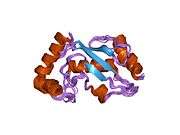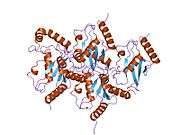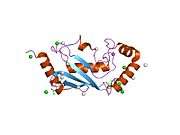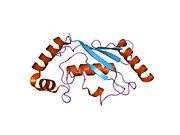UBE2D2
Ubiquitin-conjugating enzyme E2 D2 is a protein that in humans is encoded by the UBE2D2 gene.[5][6]
Function
The modification of proteins with ubiquitin is an important cellular mechanism for targeting abnormal or short-lived proteins for degradation. Ubiquitination involves at least three classes of enzymes: ubiquitin-activating enzymes, or E1s, ubiquitin-conjugating enzymes, or E2s, and ubiquitin-protein ligases, or E3s. This gene encodes a member of the E2 ubiquitin-conjugating enzyme family. This enzyme functions in the ubiquitination of the tumor-suppressor protein p53, which is induced by an E3 ubiquitin-protein ligase. Two alternatively spliced transcript variants have been found for this gene and they encode distinct isoforms.[6]
Interactions
UBE2D2 has been shown to interact with:
References
- 1 2 3 GRCh38: Ensembl release 89: ENSG00000131508 - Ensembl, May 2017
- 1 2 3 GRCm38: Ensembl release 89: ENSMUSG00000091896 - Ensembl, May 2017
- ↑ "Human PubMed Reference:".
- ↑ "Mouse PubMed Reference:".
- ↑ Jensen JP, Bates PW, Yang M, Vierstra RD, Weissman AM (Dec 1995). "Identification of a family of closely related human ubiquitin conjugating enzymes". The Journal of Biological Chemistry. 270 (51): 30408–14. doi:10.1074/jbc.270.51.30408. PMID 8530467.
- 1 2 "Entrez Gene: UBE2D2 ubiquitin-conjugating enzyme E2D 2 (UBC4/5 homolog, yeast)".
- ↑ Mace PD, Linke K, Feltham R, Schumacher FR, Smith CA, Vaux DL, Silke J, Day CL (Nov 2008). "Structures of the cIAP2 RING domain reveal conformational changes associated with ubiquitin-conjugating enzyme (E2) recruitment". The Journal of Biological Chemistry. 283 (46): 31633–40. doi:10.1074/jbc.M804753200. PMID 18784070.
- 1 2 Anan T, Nagata Y, Koga H, Honda Y, Yabuki N, Miyamoto C, Kuwano A, Matsuda I, Endo F, Saya H, Nakao M (Nov 1998). "Human ubiquitin-protein ligase Nedd4: expression, subcellular localization and selective interaction with ubiquitin-conjugating enzymes". Genes to Cells. 3 (11): 751–63. doi:10.1046/j.1365-2443.1998.00227.x. PMID 9990509.
- 1 2 Hatakeyama S, Jensen JP, Weissman AM (Jun 1997). "Subcellular localization and ubiquitin-conjugating enzyme (E2) interactions of mammalian HECT family ubiquitin protein ligases". The Journal of Biological Chemistry. 272 (24): 15085–92. doi:10.1074/jbc.272.24.15085. PMID 9182527.
- 1 2 Yu P, Chen Y, Tagle DA, Cai T (Jun 2002). "PJA1, encoding a RING-H2 finger ubiquitin ligase, is a novel human X chromosome gene abundantly expressed in brain". Genomics. 79 (6): 869–74. doi:10.1006/geno.2002.6770. PMID 12036302.
Further reading
- Rolfe M, Beer-Romero P, Glass S, Eckstein J, Berdo I, Theodoras A, Pagano M, Draetta G (Apr 1995). "Reconstitution of p53-ubiquitinylation reactions from purified components: the role of human ubiquitin-conjugating enzyme UBC4 and E6-associated protein (E6AP)". Proceedings of the National Academy of Sciences of the United States of America. 92 (8): 3264–8. doi:10.1073/pnas.92.8.3264. PMC 42146. PMID 7724550.
- Scheffner M, Huibregtse JM, Howley PM (Sep 1994). "Identification of a human ubiquitin-conjugating enzyme that mediates the E6-AP-dependent ubiquitination of p53". Proceedings of the National Academy of Sciences of the United States of America. 91 (19): 8797–801. doi:10.1073/pnas.91.19.8797. PMC 44693. PMID 8090726.
- Hatakeyama S, Jensen JP, Weissman AM (Jun 1997). "Subcellular localization and ubiquitin-conjugating enzyme (E2) interactions of mammalian HECT family ubiquitin protein ligases". The Journal of Biological Chemistry. 272 (24): 15085–92. doi:10.1074/jbc.272.24.15085. PMID 9182527.
- Anan T, Nagata Y, Koga H, Honda Y, Yabuki N, Miyamoto C, Kuwano A, Matsuda I, Endo F, Saya H, Nakao M (Nov 1998). "Human ubiquitin-protein ligase Nedd4: expression, subcellular localization and selective interaction with ubiquitin-conjugating enzymes". Genes to Cells. 3 (11): 751–63. doi:10.1046/j.1365-2443.1998.00227.x. PMID 9990509.
- Gonen H, Bercovich B, Orian A, Carrano A, Takizawa C, Yamanaka K, Pagano M, Iwai K, Ciechanover A (May 1999). "Identification of the ubiquitin carrier proteins, E2s, involved in signal-induced conjugation and subsequent degradation of IkappaBalpha". The Journal of Biological Chemistry. 274 (21): 14823–30. doi:10.1074/jbc.274.21.14823. PMID 10329681.
- Joazeiro CA, Wing SS, Huang H, Leverson JD, Hunter T, Liu YC (Oct 1999). "The tyrosine kinase negative regulator c-Cbl as a RING-type, E2-dependent ubiquitin-protein ligase". Science. 286 (5438): 309–12. doi:10.1126/science.286.5438.309. PMID 10514377.
- Tongaonkar P, Chen L, Lambertson D, Ko B, Madura K (Jul 2000). "Evidence for an interaction between ubiquitin-conjugating enzymes and the 26S proteasome". Molecular and Cellular Biology. 20 (13): 4691–8. doi:10.1128/MCB.20.13.4691-4698.2000. PMC 85887. PMID 10848595.
- Strack P, Caligiuri M, Pelletier M, Boisclair M, Theodoras A, Beer-Romero P, Glass S, Parsons T, Copeland RA, Auger KR, Benfield P, Brizuela L, Rolfe M (Jul 2000). "SCF(beta-TRCP) and phosphorylation dependent ubiquitinationof I kappa B alpha catalyzed by Ubc3 and Ubc4". Oncogene. 19 (31): 3529–36. doi:10.1038/sj.onc.1203647. PMID 10918611.
- Fang S, Ferrone M, Yang C, Jensen JP, Tiwari S, Weissman AM (Dec 2001). "The tumor autocrine motility factor receptor, gp78, is a ubiquitin protein ligase implicated in degradation from the endoplasmic reticulum". Proceedings of the National Academy of Sciences of the United States of America. 98 (25): 14422–7. doi:10.1073/pnas.251401598. PMC 64697. PMID 11724934.
- Yu P, Chen Y, Tagle DA, Cai T (Jun 2002). "PJA1, encoding a RING-H2 finger ubiquitin ligase, is a novel human X chromosome gene abundantly expressed in brain". Genomics. 79 (6): 869–74. doi:10.1006/geno.2002.6770. PMID 12036302.
- Xia Y, Pao GM, Chen HW, Verma IM, Hunter T (Feb 2003). "Enhancement of BRCA1 E3 ubiquitin ligase activity through direct interaction with the BARD1 protein". The Journal of Biological Chemistry. 278 (7): 5255–63. doi:10.1074/jbc.M204591200. PMID 12431996.
- Takeyama K, Aguiar RC, Gu L, He C, Freeman GJ, Kutok JL, Aster JC, Shipp MA (Jun 2003). "The BAL-binding protein BBAP and related Deltex family members exhibit ubiquitin-protein isopeptide ligase activity". The Journal of Biological Chemistry. 278 (24): 21930–7. doi:10.1074/jbc.M301157200. PMID 12670957.
- Xu L, Yang L, Moitra PK, Hashimoto K, Rallabhandi P, Kaul S, Meroni G, Jensen JP, Weissman AM, D'Arpa P (Aug 2003). "BTBD1 and BTBD2 colocalize to cytoplasmic bodies with the RBCC/tripartite motif protein, TRIM5delta". Experimental Cell Research. 288 (1): 84–93. doi:10.1016/S0014-4827(03)00187-3. PMID 12878161.
- Subramaniam V, Li H, Wong M, Kitching R, Attisano L, Wrana J, Zubovits J, Burger AM, Seth A (Oct 2003). "The RING-H2 protein RNF11 is overexpressed in breast cancer and is a target of Smurf2 E3 ligase". British Journal of Cancer. 89 (8): 1538–44. doi:10.1038/sj.bjc.6601301. PMC 2394340. PMID 14562029.
- Shimura H, Schwartz D, Gygi SP, Kosik KS (Feb 2004). "CHIP-Hsc70 complex ubiquitinates phosphorylated tau and enhances cell survival". The Journal of Biological Chemistry. 279 (6): 4869–76. doi:10.1074/jbc.M305838200. PMID 14612456.
- Lehner B, Semple JI, Brown SE, Counsell D, Campbell RD, Sanderson CM (Jan 2004). "Analysis of a high-throughput yeast two-hybrid system and its use to predict the function of intracellular proteins encoded within the human MHC class III region". Genomics. 83 (1): 153–67. doi:10.1016/S0888-7543(03)00235-0. PMID 14667819.
- Winkler GS, Albert TK, Dominguez C, Legtenberg YI, Boelens R, Timmers HT (Mar 2004). "An altered-specificity ubiquitin-conjugating enzyme/ubiquitin-protein ligase pair". Journal of Molecular Biology. 337 (1): 157–65. doi:10.1016/j.jmb.2004.01.031. PMID 15001359.

















